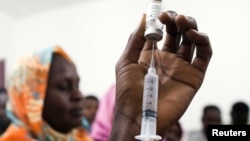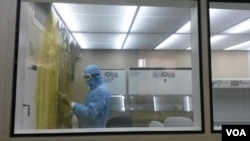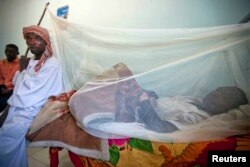Angola is battling a yellow fever outbreak amid a global shortage of the vaccine. Cases have also been reported in the Democratic Republic of Congo, Kenya, Uganda and China.
Health experts worry about further spread. There is no treatment.
Mass immunization is the only way to stop yellow fever, but producing more of the vaccine is not easy.
Making of a vaccine
The Institut Pasteur de Dakar is one of four places in the world that make the yellow fever vaccine.
Recording is prohibited inside the institute, but there is nothing to hear. The halls are quiet. Two walls of windows separate us from the sterile labs where technicians work in head-to-toe protective gear.
Each week, a carton of special, pathogen-free chicken eggs arrives from Germany. Technicians inject the embryos, one by one, with the live virus. That’s a first step. What follows is weeks of extraction, mixing, incubation and safety checks.
It can take up to six months to produce a batch of usable vaccine.
Globally, around 80 million doses of yellow fever vaccine are made each year. The Institut Pasteur can produce up to 10 million doses.
Meeting global needs
Antoine Marie Diatta is the quality control manager for yellow fever vaccine production at the institute. He said unfortunately our production capacity can’t always meet the global needs. It’s the same for other manufacturers, he said. This can be a problem when there is an epidemic, he said, because then there is an immediate need to vaccinate a large number of people.
It can be hard to predict how much vaccine will be needed.
Yellow fever vaccines can be stored for up to three years, but manufacturers can't afford to over produce, as Diatta explained.
He said money is invested to make each batch of vaccine and you must wait for your return. It’s not easy. He said while you wait to sell, you still need to pay salaries and update equipment, but your money is tied up.
Yellow fever is endemic to 34 countries in Africa. It is spread through the bite of an infected mosquito. A single dose of the vaccine can protect you for life.
UNICEF’s chief of child survival and development in Angola, Samson Agbo, said 80 percent of people living in high-risk areas need to be vaccinated to prevent an epidemic. In many parts of Africa, immunization rates are below 60 percent.
“The high-risk countries are known. Ideally, those high-risk countries should have a very strong immunization programs, which means you are reaching every child," said Agbo. "We need to invest more if we want to prevent occurrences like this, this kind of outbreak.”
Nearly 2,000 cases have been reported in Angola since the outbreak began in October 2015.
A mass vaccination campaign was launched in February, using 6 million doses from emergency stockpiles.
Averting an outbreak
An additional 10 million doses were made available by the International Coordinating Group on Vaccine Provision and UNICEF in late March.
While this has slowed the spread of the virus, the World Health Organization (WHO) warns that if the outbreak spreads to other countries, the now-depleted stockpiles could impact routine vaccination campaigns, putting millions more at risk.
“What we really need to do is make sure there are enough funds and that we work with manufacturers to see how production can be increased," stated Tarik Jasarevic, spokesperson for the WHO. "We already heard from some manufacturers they can increase production. We’ve replenished now our stockpiles and just hope we can contain this outbreak in Angola, so there would be no need for additional doses that we may not have.”
Three other labs in the world produce yellow fever vaccine. They are in Russia, France and Brazil.
The Institut Pasteur said plans are under way to open a new facility on the outskirts of Dakar by 2020 to increase production here.









